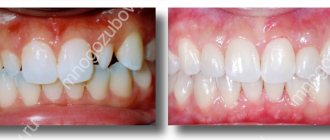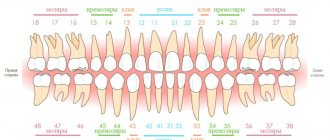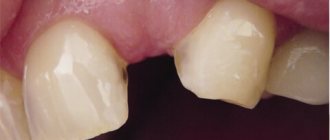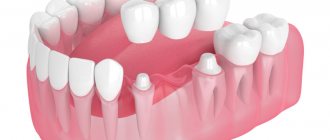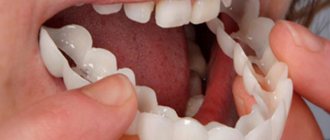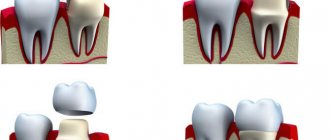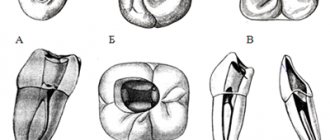- home
- Services
- Dental restoration for children
Baby teeth appear in a child from 6-9 months and are replaced by permanent teeth until the age of 12-14 years. Children's teeth, especially at an early age, are very vulnerable and susceptible to decay. It is careful attention to baby teeth that is the key to timely and correct growth of permanent dentition. A child with straight and beautiful teeth develops chewing and facial muscles correctly. Premature loss of even one baby tooth, untreated caries, crown injuries lead to the following problems:
- increased load on neighboring teeth;
- violation of growth order;
- deformations of the entire dentition;
- the occurrence of diction defects;
- deterioration of chewing function;
- aesthetic defects.
Changing the position of the rudiments of permanent teeth is a high risk of serious malocclusion, which is fraught with serious orthodontic treatment in the future. Natadent clinic specialists fight for every child’s tooth.
What is dental restoration
Restoration of baby teeth in children is carried out in the following cases:
- for damage caused by trauma;
- due to complicated caries.
Dental injuries in childhood are common. At the children's dental clinic "Natadent" we are ready to provide timely and qualified assistance. According to statistics, every third child suffers a tooth injury during sports games or vigorous activity.
By acting correctly, you can even save a knocked out tooth:
- Regardless of the severity of the injury, you should come for an examination to a pediatric dentist;
- take a photo to assess the nature of the damage;
- if displaced, the tooth must be strengthened by applying a splint or in another way at the discretion of the doctor;
- Deliver the child, along with the knocked out tooth, to the dentist’s office within 30 minutes.
Important! A knocked-out tooth cannot be picked up by the root, washed with water or treated with antiseptic solutions - this can make the process of its healing impossible and complicate restoration. It must be carefully taken by the crown and placed in saline solution, on the child’s cheek or in another biological environment.
If a piece of enamel breaks off from an injured tooth and dentin is exposed, then it cannot be left in this form. It is necessary to see a dentist and restore the damaged edge. Through a thin layer of dentin, pathogenic bacteria will enter the pulp and cause pulpitis. This can lead to tooth decay and costly treatment.
The Natadent clinic has all the possibilities for preserving teeth, restoring them and restoring them. We are sure that tooth injury is not a reason for losing it.
Metal crowns for temporary teeth
Engel first talked about preformed metal crowns for temporary teeth in 1950, and with the help of Humphery, crowns gained popularity. Standard steel crowns for primary teeth are still used today. These crowns have many advantages, but one significant drawback is the lack of aesthetics. This makes metal crowns unsuitable for the restoration of anterior teeth. Manufacturers offered crowns with veneers for the anterior and posterior teeth, but the aesthetic requirements for primary teeth were constantly growing, which contributed to the creation of standard zirconium crowns for temporary teeth. Developments in this area continue, and many pediatric dentists are now creating custom aesthetic crowns.
Below we will talk in more detail about restoring damaged temporary teeth using standard metal crowns.
What are the positive qualities of standard metal crowns?
- Preserve severely damaged primary teeth until their physiological replacement.
- Maintain chewing function.
- They have a relatively low cost (compared to zirconium crowns).
- With a sufficient level of theoretical knowledge and practical skills, they are easily and simply recorded.
- Fixed in one visit.
- Antagonists do not harm.
- Correspond to the anatomical shape of the tooth.
- Contribute to the preservation of a sufficient volume of healthy hard tissues of a temporary tooth (the thickness of a standard metal crown is 0.2–0.3 mm).
When working with these crowns, novice pediatric dentists have many questions. I will try to highlight the most important, in my opinion, aspects:
- Determining the size of the crown before starting preparation. To do this, you can measure the mesiodistal size of the tooth in the oral cavity - manufacturers indicate the width for each crown size. Knowing the size of the tooth before preparation, you can easily select the size of the crown.
- Anesthesia. This stage is not always necessary, but most often it is necessary, because during the preparation of the tooth the gingival margin is inevitably injured.
- Isolation with a rubber dam is necessary if vital amputation or extirpation of the dental pulp is necessary before fixing the crown.
- It is better to start the preparation itself from the occlusal surface, the preparation depth is 1–1.5 mm.
- Preparation of proximal surfaces should be carried out from the mesial and distal surfaces. It is especially important to prepare the distal surface of the fifth teeth, since the absence or insufficient preparation of this surface can cause displacement of the crown at the time of eruption of the first permanent molar. The preparation of these surfaces must be gentle; damage to adjacent intact teeth is unacceptable!
- It is important that the crown is not too long. The edge of the crown should extend approximately 1 mm below the gingival margin. If the edge of the crown goes deep, then it is necessary to install the crown on the tooth, measure the gingival edge on the crown with a bur, remove the crown from the tooth and correct the length with special scissors. Afterwards, you need to carefully polish the edge of the crown.
- Cements for fixation can be: zinc phosphate, GIC, based on COE, glass ionomer, polymer modified.
- After fixing the crown, it is necessary to remove excess cement.
It is important to warn the child and parents about the occurrence of discomfort (painful sensations) in the area of the injured gum, explain that these sensations will decrease and complete healing will occur within a few days.
Recovery methods
Several methods can be used to restore a child's teeth. The type of restoration is chosen by the dentist depending on the nature and degree of destruction.
The difficulty of a dentist’s work during the process of tooth restoration is that children quickly get tired due to the need to remain static in a chair. Therefore, the Natadent Children's Dental Clinic provides the possibility of dental treatment under local anesthesia, general anesthesia or inhalation sedation.
Sealing
If a tooth is partially damaged, the dentist evaluates the condition of the remaining hard tissues and the quality of the soft tissues around the crown and roots. The following filling options are possible:
- treatment of the canals of a baby tooth and placing a filling at the gum level so that the tooth is not in the bite and does not experience stress;
- restoration using filling material.
Light-curing composite materials have many advantages:
- the dentist can completely build up a child’s tooth and recreate the crown relief;
- the chewing surface becomes durable;
- there is no release of harmful substances into the child’s body;
- the material hardens under UV light;
- You can achieve a high cosmetic effect and the required degree of transparency of the filling.
To prevent the formation of cracks during the life of the child and during shrinkage, the dentist forms a filling when building up layer by layer. The composite has the ability to hermetically close any microcracks and firmly connect to dentin.
Light-composite materials are a real innovation in dentistry, with the help of which filling and restoration of teeth has become less traumatic and most effective.
Crown installation
Carrying out this procedure in children is surprising, but not among the specialists at the Natadent clinic.
It is recommended to use the following method:
- for large chips;
- with significant tooth destruction of 50% or more.
If the chewing surface and one of the side walls of the tooth are lost, the remaining thin walls will not withstand the chewing load for a long time.
Installing a crown is a reliable way to save a baby tooth from destruction and maintain its functionality until it is replaced with a permanent one.
Crowns help:
- chew food thoroughly, which is important for the vulnerable gastrointestinal tract system;
- prevent the appearance of persistent speech defects, which is especially important during the period of active development of the child and preparation for school;
- form the correct bite.
Timely protection of teeth with crowns is an opportunity to minimize further destruction of baby teeth, the development of secondary caries and prevent improper development of permanent teeth.
Natadent pediatric dentistry uses two types of crowns:
- ceramic for the front teeth, which do not differ from natural incisors in color and shape and do not violate the aesthetics of the smile;
- metal, made of stainless steel, which are the ideal solution for restoring the function of chewing teeth.
Modern crowns are high-quality products with a unique design; they do not require significant grinding of the tooth, but significantly prolong its life. At the clinics of the Natadent network, we restore teeth for children in the same aesthetic and beautiful way as for adults.
When are children's crowns needed?
- A baby tooth is destroyed by caries by 50% or more, or after treatment with nerve removal, when the dental tissues are thinned and there is a risk of breaking off the remaining part of the tooth - this risk is high, even if there is a filling. In this case, the crown will help restore full chewing function.
- Caries destroys many teeth at once.
- The teeth are destroyed along the chewing and contact surfaces to the level of the gums and below.
- If the palatal, chewing (or cutting) and outer surfaces of the tooth are simultaneously affected or it is destroyed by circular caries.
- If the tooth erupted with impaired development of enamel and/or dentin.
- In case of bruxism (if the child begins to grind his teeth in his sleep).
- In case of injury, chipped baby tooth.
If the child is treated under general anesthesia, in one session the doctor will heal the tooth and install a crown, which will preserve its integrity, restore chewing function and guarantee protection from subsequent destruction by caries.
Reviews
Your feedback is to help potential patients make the right choice. Leave your suggestions or comments so we can work even better.
LEAVE FEEDBACK
Sealing
Filling is the only method of artistic restoration of teeth that does not have any age restrictions. In this case, not only primary, but also dairy units should be subject to restoration. It is very important to restore all fissures, tubercles and irregularities on the teeth lost due to caries or injuries, because they are necessary for thoroughly chewing food.
Baby teeth can be restored using colored filling materials, which is very popular with young children. However, such fillings can only be installed on the surface of chewing teeth; they are not used in the smile area.
Of course, it can be very difficult for a small child to sit still for 30-60 minutes while the dentist is working. No more than one tooth can be restored at a time. In addition, most children are very afraid to visit doctors, so restoration has to be postponed for several years.
When do you need to restore baby teeth?
There are three main areas in the field of primary occlusion prosthetics:
- restoration, which is required if the aesthetics are compromised or a small part of the crown breaks off,
- restoration of the apex by installing a crown,
- complete restoration if the tooth was removed along with the root.
Restoration must be carried out. Firstly, for the sake of aesthetics - this is especially important if the child is at an age when the opinions of his peers greatly influence the child’s mood and psychological comfort. Secondly, to normalize nutrition and eliminate pathologies of the gastrointestinal tract. If even part of the teeth are missing, the child may chew food poorly, which will affect the digestive organs. And the third reason why prosthetics must be carried out is the protection of the entire jaw system.
If chewing is uneven (on one side), facial asymmetry may appear. If there are no teeth, the rest will begin to shift, so there will simply be no room left for the permanent ones. Another consequence is a violation of the position of the antagonists that are located on the opposite jaw. Due to the fact that they will not have support, they will move vertically, i.e. fall out of the hole.


